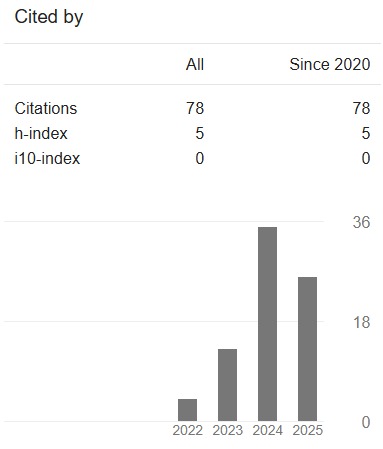Two-Dimensional Aerodynamic Analysis of Multiple-Elements Airfoils Using Computational Fluid Dynamics (CFD) Software
DOI:
https://doi.org/10.24191/jaeds.v5i2.142Keywords:
Computational Fluid Dynamics, NACA 2412, Multiple- Airfoil, Lift coefficient, Drag coefficientAbstract
Multiple-element airfoils consist of two or more airfoil sections positioned closely together, and they are commonly used to enhance lift during takeoff and landing. These configurations can be found in aircraft wings and wind turbines because of their ability to generate greater lift and improve aerodynamic performance. However, optimizing their arrangement can be challenging, as suboptimal configurations may lead to increased drag. This study examines three multiple-airfoil configurations: (A) NACA 2412–NACA 0012, (B) NACA 2412–NACA 2415, and (C) NACA 2412–Clark Y. Computational fluid dynamics (CFD) simulations were conducted using ANSYS Fluent with the Spalart–Allmaras turbulence model at a Reynolds number (Re) of 1.34 × 10⁶ and a velocity (V) of 20 m/s. The lift and drag characteristics were analysed for angles of attack (ranging from 0° to 19°). The results indicate that all configurations exhibit similar trends in lift and drag; however, Set C demonstrates a delay in stall, while Sets A and B achieve the highest lift-to-drag ratio (approximately 32) at an angle of 5°. These findings enhance our understanding of the performance of multi-element airfoils and their role in improving aerodynamic efficiency during takeoff.
Downloads
References
. J. D. Al-Khafaji, G. S. Panatov, and A. S. Boldyrev, “Investigating the Effects of Multi Aerofoil Wing on the Aerodynamic Characteristics,” in 5th Int. Conf. Eng. Technol. its Appl.(IICETA),2022, pp. 133–139, doi: 10.1109/IICETA54559.2022.9888511.
N. R. Kluga, “A Study of Flap Management, an Analysis of the Consequences of Flap Management, and a Search for Possible Causes,” J. Aviat. Educ. Res., vol. 1, no. 3, pp10-25 1991, doi:10.15394/jaaer.1991.1026.
H. H. Hurt Jr., Aerodynamics for Naval Aviators (rev. ed.). The Office of the Chief of Naval Operations, Aviation Training Division. NAVAIR OD-80T-80. Los Angeles, CA: University of Southern California, 1965 (Online). Available: https://www.faa.gov/sites/faa.gov/files/regulations_policies/handbooks_manuals/aviation/00-80T-80.pdf
D. Foster, H. Irwin, and B. Williams, “The Two-Dimensional Flow Around a Slotted Flap,” Aeronaut. Res. Counc. Reports Memo. 3681, no. 3681, 1971.
S. Hariyadi, B. Juni Pitoyo, N. Pambudiyatno, Sutardi, and W. A. Widodo, “Numerical Study on Single and Multi-Element NACA 43018 Wing Airfoil with Leading-Edge Slat and Slotted Flap”, Int. J. Automot. Mech. Eng., vol. 21, no. 3, pp. 11652–11662, Sep. 2024, doi: 10.15282/ijame.21.3.2024.16.0899.
E. Mohammad, J. Saeed, A. Fatemeh, K. Ahmad and A. Hassan. (2025). Numerical Simulation of Wavy-Flap Airfoil Performance at Low Reynolds Number: Insights from Lift and Drag Coefficient Analysis. 10.48550/arXiv.2503.05028.
C. Velkova and M. Todorov, “Study of the Influence of a Gap Between the Wing and Slotted Flap on the Aerodynamic Characteristics of Ultra-Light Aircraft Wing Airfoil,” Rev. Air Force Acad., vol. 13, no. 3, 2015, pp. 39–44. doi: 10.19062/1842-9238.2015.13.3.6.
D.C. Wilcox, Turbulence Modelling for CFD 3rd Edition. 1993. [Online]. Available: http://www.dcwindustries.com
B. E. Launder and D. B. Spalding, “The Numerical Computation Of Turbulent Flows,” Comput. Methods Appl. Mech. Eng., vol. 3, no. 2, 1974, pp. 269–289.doi: 10.1016/0045-7825(74)90029-2.
L. Howarth, “Theory of Wing Sections,” Physics Bulletin, vol. 11, no. 10. 1960, pp. 210–255. doi: 10.1088/0031-9112/11/10/006.
P. R. Spalart and Allmaras S.R., “A one-equation turbulence model for aerodynamic flows,” La Recherche Aerospatiale, no. 1. 1994, pp. 5–21.
R. Allocious Britto Rajkumar; N. Mohammed Raffic; Dr. K. Ganesh Babu; V. Vignesh, “Comparative Study on Effective Turbulence Model for NACA0012 Airfoil using Spalart – Allmaras as a Benchmark,” Int. J. Trend Sci. Res. Dev., vol. 4, no. 3, pp. 1049–1056, 2020, [Online]. Available: http://www.ijtsrd.com/papers/ijtsrd30824.pdf%0Ahttps://www.ijtsrd.com/engineering/aeronautical-engineering/30824/comparative-study-on-effective-turbulence-model-for-naca0012-airfoil-using-spalart-–-allmaras-as-a-benchmark/r-allocious-britto-rajkumar
S. L. Brunton, B. R. Noack, and P. Koumoutsakos, “Machine Learning for Fluid Mechanics,” Annu. Rev. Fluid Mech., vol. 52, pp. 477–508, 2020, doi: 10.1146/annurev-fluid-010719-060214.
“AirfoilTools.” Accessed: Jan. 07, 2025. [Online]. Available: https://www.airfoiltools.com/
K. Ghulam, F. Ali, and A. A. Khan Gorar, “Optimizing the Performance of different Airfoils at Various Angles of Attack through CFD Simulation,” Int. J. Sci. Res. Sci. Eng. Technol., vol. 11, no. 2, pp. 23–36, 2024, doi: 10.32628/ijsrset2411145.
Downloads
Published
How to Cite
Issue
Section
License
Copyright (c) 2025 Zurriati Mohd Ali, Nor Afifah Yahaya, Iskandar Shah Ishak, Fakhrul Fahmi Zamzuri, Ahmad Fathi Azad

This work is licensed under a Creative Commons Attribution 4.0 International License.








